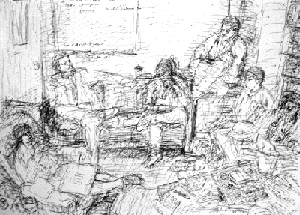

'Case Discussion Before Making Rounds'
(ink drawing, 22' x 30')
©May H. Lesser
Professor: "Who else do we have?"
Student: "We have 'Willy Jones'; he had a pleural effusion."
Professor: "How do we know?"
Student: "Well, he had 75,000 poly, ILD is 85."
Professor: "Did you get a PH on him? I would assume it would be low with 75,000. Did he grow anything out of there? So he had normal renal function when he came in and sometime after that he had renal failure requiring dialysis?"
Student: "And they kept saying perhaps it was due to hypertension. I looked at all the blood pressures and there was not one that indicated hypertension."
Professor: "So how do you approach somebody with acute renal failure?"
Student: "You look for possible drug problems."
Professor: "Even before that. How do you divide up patients by the cause of acute renal failure? You usually divide up into three categories. You can ask consultants if you need to. Is it renal or is it post renal? So how do you rule out the post renal? How do you do that? In the male, that's not an unusual thing, so how do you rule that out? "Usually prostatic hypertrophy and how do you find out if this person has bladder outlet obstruction? What would be the best way to rule out whether this guy gets bladder outlet obstruction? Give me a single test? Something you can do at the beds." And so the professor went through each students' notes on each patient they had examined on the wards. They will accompany him as he examines the same patients. This is the way they develop judgment to integrate the facts they have learned from books and laboratory results.
Last Reviewed: May 11, 2012

